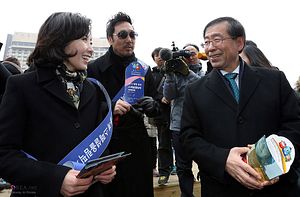As the final votes were counted in South Korea’s local elections, the ruling Saenuri party breathed a sigh of relief. Not only did President Park Geun-hye’s conservative party retain its powerbases in North Gyeongsang province and Busan, it also won the hotly contested races in Gyeonggi Province and Incheon. With eight out of seventeen available gubernatorial and mayoral seats under Saenuri control, the ruling party had eked out more popular support than was expected.
Meanwhile, the opposition New Politics Alliance for Democracy (NPAD) party was criticized for its inability to take advantage of the current government’s mistakes and weaknesses. Despite taking one more seat than the ruling party and retaining the all-important mayorship of Seoul, popular opinion suggests that people who voted for the opposition did so in support of specific candidates (like Mayor Park Won-soon of Seoul) and not as a vote of confidence in the NPAD. This is a poor start for a party hoping to make a good showing in the by-elections coming up in July and October.
In South Korea’s volatile political environment, the ruling party almost always performs poorly in local elections. This is because the gubernatorial and mayoral races often become focal points for public dissatisfaction towards the presidential administration. Most famously, President Roh Moo-hyun’s Uri Party lost all but one seat in the 2006 local election, while the Grand National Party (as the Saenuri Party was known at the time) took twelve of the sixteen available seats. So it is more the surprising that the ruling party managed to retain so many seats this year, considering the public’s outrage over the Sewol ferry disaster, the rapid decline in Park’s approval rating, and the forced resignation of the prime minister-designate after his personal assets were called into question.
At the same time, there is one trend worth keeping in mind when analyzing the most recent results. Because local elections take place every four years and presidential terms last five years, the mayoral and gubernatorial races occur at different times for successive administrations. The ruling party tends to perform better in local elections if they occur in the first half of the presidential term. Case in point, the Kim Dae-jung administration (1998-2003) faced two local elections; in the 1998 local election, the ruling party tied the Grand National Party with each taking six seats, but the conservative opposition managed to rally in 2002 and sweep eleven of the sixteen available seats. Likewise, considering this is Park Geun-hye’s second year in office, it is likely that the support for the president and her party remains strong among those who had voted for Park in the 2012 presidential election.
Nonetheless, analysts note that the dramatic circumstances of this year’s election should have provided ample opportunity for the liberal opposition to buck this trend. While the NPAD is placing emphasis on the fact that it had taken back the mayoral seat in Daejeon, thereby placing all of central South Korea (North and South Chungcheong provinces and Daejeon metropolitan) under opposition control, many supporters remain critical of how the party had handled its election campaign.
In particular, the party failed to capitalize in key areas where the race was expected to be close. Gyeonggi Province, where the NPAD lost by merely 0.85 percent of votes, is a prime example. Many, including several opposition assemblymen, criticized the NPAD leadership for failing to actively campaign for the gubernatorial seat in this critical province, which had been held by the conservatives since 2006.
Instead of focusing on seats where the conservative candidates were vulnerable, the NPAD was overly distracted by the challenge posed by an independent candidate in the liberal powerbase of Gwangju metropolitan. As a result, the opposition focused heavily on a race where the chief opponent was not a Saenuri candidate, while the ruling party, threatened by polls showing its waning popularity, campaigned harder than ever. In the end, the NPAD mayoral candidate for Gwangju won comfortably with 57.9 percent of the votes while Saenuri candidates in Gyeonggi Province and Incheon won by a hair’s breadth, a strategic blunder by the opposition.
Many now suggest that the opposition had relied too heavily on the public’s outrage over the government’s handling of the ferry disaster without realizing that it had not offered any tangible solutions or policies of its own. As a result, the Saenuri Party’s control over the country has hardly changed.
One thing that has changed, however, is the complete absence of mayoral and gubernatorial seats taken by third-party winners. With the various conservative and liberal factions now more or less united around the two key political parties, the 8-9 division between the ruling party and the opposition may be a reflection of the ideological polarization in South Korea and a preview of the upcoming by-elections and the 2016 legislative elections.
































